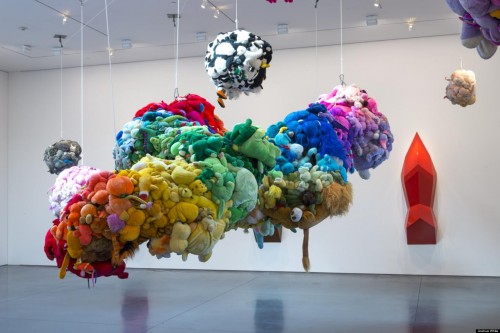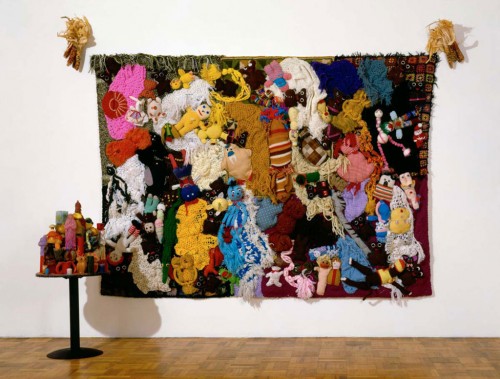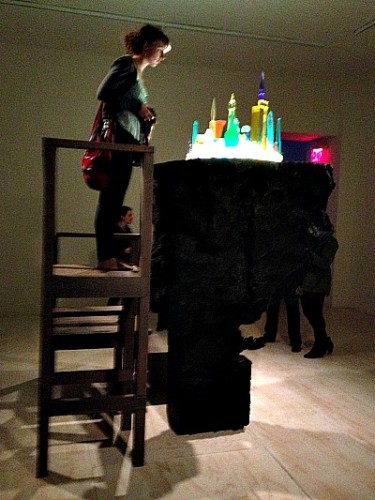This is a test. Can you look at Mike Kelley’s huge survey (MoMA PS1 to Feb. 2) without thinking of how he died? Is it too soon to come to grips with the art?
Recent evidence has emerged that St. Vincent was shot by some stupid boys by mistake. Nevertheless, van Gogh’s “suicide” haunts even the most cheerful of his landscapes. That haunting and the fading of certain colors shows how both false history and bad chemistry are art’s most dangerous collaborators.
I will not assume that Kelley’s obsession with his own childhood in his art had something to do with his 2012 suicide. These kinds of dreadful things are usually multi-causal: relationships or lack of, career ruts, alcoholism, deep depression, drugs. The usual list.
Nevertheless, Kelley is dead and nothing I say may hurt him. It is obvious already that his best work is also his debut work, and in part this is because it is so problematic. Grubby stuffed animals became his trademark, whether stitched together to make a “tapestry” (More Love Hours Than Can Ever Be Repaid, 1987), grouped together in hanging balls (Deodorized Central Mass with Satellites, 1991-95), under a big rug or deployed on blankets on the floor. They make us cringe; they make us look at thrift-shop toys with new eyes. The stuffed toys are not only his signature works but are also what mark as a prime example of Infantilismo — the dark side of bright, sunny, googie California.. Infantilismo is the suburbia of the mind.
Isolation. Nightmare rec rooms. Bad TV. Lawns that are fences that might as well be barbed wire. Ken and Barbie sex orgies on the abject sectional or under the wood-panel station wagon. Paint-by-number clown art. Uh-oh. Starting to sound glamorous.
Infantilismo — a subset of Kinderkunst — is the use by male artists of boys’ toys as subjects/forms. It is childishness run rampant. It is a male, bad-boy version of complaint-centered “feminism.” It is nostalgia for boyhood. It is also, I fear, a pathetic attempt to maintain gender signifiers in a new world in which gender is fluid.
Kelley’s stuffed stuff makes it seem that shrinks never existed or, worse yet, is the proof at last that psychoanalysis doesn’t work. An alternative reading is that therapy may allow too much self-indulgence. I didn’t have enough toys; I had too many toys; I didn’t have the right kind of toys. My toys were not big enough. Remember the Peter Pan Syndrome? Well, that has become the Peter Panic Syndrome.
What healthy male wants to grow up to be a commodities trader or banker? Or suited CEO of some idiotic earth-marauding corporation? Or an artist, whose main job now is to provide investment opportunities for people with too much cash for their own good?
After goo-goo toys, Kelley’s next best work is his Kandor series (1999-2011). Kandor was a city on Superman’s home planet, Krypton. It was shrunk down by the villainous Brainiac to fit into a glass jar. Rescued and brought to earth by Superman, where disguised as mild-mannered Clark Kent. …
For his Kandor series, Kelley made expensive-looking, three-dimensional models of the various appearances of Kandor through the years in DC Comics. Like the stuffed-animal works, there is not one iota of irony. As you well know, California Infantilismo does not countenance irony. Irony is too New York.
And the rest? Well, let’s put it this way, this is not a tightly curated show. The life-sized replica of Kelley’s childhood ranch house (Mobile Homestead, which debuted last May at the Institute of Contemporary Art, Detroit, is not at MoMA PS1. I guess it would have been too much trouble to remove Volkswagen’s geodesic media-dome from the courtyard. Or maybe the ICA Detroit has a lock on it. Could be, since what is Kelley’s masterpiece is positioned across the street from MOCA Detroit and will function as a community center.
On the other hand, inside the hallowed halls of PS1, which was once a premier avant-garde venue, there are far too many of Kelley’s banners, drawings, pieces of folk art and Outsider Art knockoffs, as well as a ghastly collection of 30 “installations” (Day Is Done, 1995), inspired by yearbook pictures.
Some might argue that Kelley was primarily a performance artist. If so, all the actual things he made should be hidden away. What would we have left? Some really dumb videos. These, alas, do not make much of a case for him as a performance artist. Sorry. Performances come and go, and what we see at PS1 is the stuff we are stuck with.
Infantilismo Redacted
The other important Infantilismos are Chris Burden (a hard-core pioneer, of sorts), Jeff Koons and Paul McCarthy, with his L.A. obsession with Disney and Snow White.
The king of deadpan, possibly ironic Infantilism is the East Coast’s Koons, who is now the most successful artist on earth and day by day getting even more so. His balloon-dog pieces, like their originals, are aimed at boys. These wacky, mirror-finished sculptures present gigantic versions of inflated sausage casings or penises disguised as kiddie party-toys. All great fun to play with, if you are an infant.
The Koons balloon sculptures, like his classic seven-story flower puppy, are replete with ambiguity and, I suppose, irony. But wait a minute. Don’t girls get offered balloon sculptures at birthday parties too? They get balloon princess crowns. Just watch any balloon clown at a birthday party and you will see what I mean. Boys get puppies; girls get headgear.
Jason Rhoades’ Creation Myth (1998), which can now be seen in “Four Roads” at Philadelphia’s ICA (to December 29), has a toy train with a stuffed snake. Does one work, no matter how intense or complex, qualify an artist to be included in the annals (or anals) of Infantilismo? Oh, no. We would then have to include Maurizio Cattelan because of his poignant, bathetic Pinocchio, lying face down in the first-floor pool at the Guggenheim in 2008.
Sorry, Boys. The rest of the world is not all that interested in stuffed animals, erector sets or Snow White and the Seven Dwarfs. We have moved on. Unless … unless Infantilismo is meant as critical. Alas, it has not been received as such.
I am not saying that the artists I have labeled as Infantilismos are infantile themselves, or that they may be merely accusing other males of being such. Perhaps they are cynical and know their market. Who buys art? Mostly rich men. Why not add one more toy to the panoply of sports cars, gold watches, man caves, penthouses and vacation lairs? Why not indulge the Infantilismo of the target market?
Give us more. Bigger and slicker. More daring, but not too daring. More personal, but not too personal. Different styles, formats, forms. Show us you can dance, fence, box, and do somersaults. Show us your stuff. And I want one of each.
The Jig Is Up
Now, to pick up another thread, there is one more factor that is also taboo. Far too many artist do their best work when they are still in art school and have nothing to lose, still on the parental dole. It is as if not knowing any better and not knowing much about real life sets them free. Or perhaps they are the sock puppets of their teachers. And then, for whatever reason, they just keep on going, one artwork after another, each one less inspired. And — here’s the worst part — no one seems to catch on to that for years, decades.
Is there something you don’t understand about the phrase “running on empty?” Once you are a “success,” your gallery, your collectors, your staff, your family all demand more product. Collectors and investors want to see product, lots of product. Making art costs more and more. You need that perfect studio. You need an army of assistants. And artists, like everyone else, live longer and longer. As you age — cheerful thought — you are more and more trapped by your past.
Kelley’s career is instructive. He was overpraised at the beginning and the praise kept rolling in. It shows you what can happen to art without serious art criticism, letting the market call the shots.
John Perreault is on Facebook. Links for John Perreault website & John Perreault’s art.







